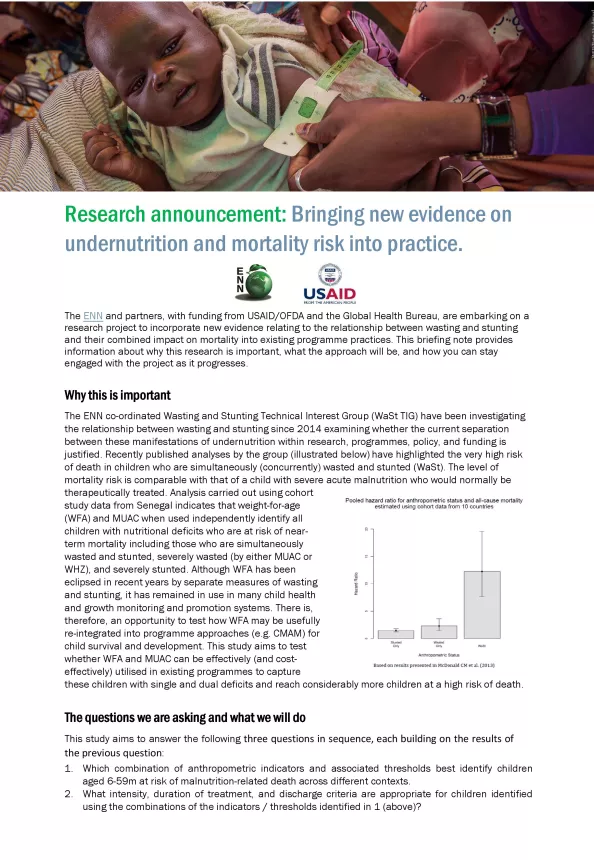The WaSt study Protocol and Opportunities for Collaboration: bringing new evidence on undernutrition and mortality risk into practice.
Publication details
The WaSt study Protocol and Opportunities for Collaboration: bringing new evidence on undernutrition and mortality risk into practice.
The ENN and the Wasting Stunting Technical Interest Group (WaSt TIG), with funding from USAID via the Bureau of Humanitarian Affairs (BHA) and Bureau for Global Health, in 2018 embarked on a research project to incorporate evidence generated by the WaSt TIG on the relationship between wasting and stunting and their combined impact on mortality, into programming approaches. Analysis carried out by the group had highlighted the increased mortality risk for children simultaneously wasted and stunted and the potential offered by the use of a weight-for-age (WFA) indicator (<-3 z scores) alongside low MUAC, to identify these children, at high risk of death, for treatment. Although WFA has been eclipsed in recent years by separate measures of wasting and stunting, it has remained in use in many child health and growth monitoring and promotion systems. This provided an opportunity and incentive to test how WFA may be usefully and cost-effectively re-integrated into treatment programme approaches and services (e.g. CMAM) focussed on achieving impacts on child survival and development.
A research announcement for the project was published in 2019 detailing the background and proposed approach. This was followed by the development by ENN and the WaSt TIG of a study protocol for the first stage of the research, a cohort study, to test the intensity, duration of treatment, and discharge criteria appropriate for children identified using WAZ < -3 and MUAC < 115mm (see WaSt cohort study briefing note).
A partnership with ACF for implementation of this WaSt cohort study in Nigeria starting in 2020 was secured. However, various challenges including the COVID pandemic through 2020/21 caused considerable delays to plans for study implementation and as a result it has not been possible to continue with those plans.
ENN are therefore publishing the full cohort study protocol developed with the WaSt TIG here. Our aim in sharing it is to promote learning and enable organisations and/or donors who may be interested in incorporating the study into their own work plans in the near future to see what it may entail. ENN are happy to release this protocol for use by others. However this is an innovative approach and one which ENN and the WaSt TIG are continuing to build evidence for, including through further analysis on existing data sets. We would therefore very much like to collaborate, in an advisory role, with any organisations interested in implementing the cohort study so that we can share accompanying study tools that had been developed and continue to contribute the collective experience of the WaSt TIG, and our ongoing pieces of analysis to its implementation.
If a collaboration on the cohort study and/or beyond would be of interest to you - please get in contact with Tanya Khara (ENN Technical Director and Coordinator of the WaSt TIG) on tanya@ennonline.net
We request that ENN, The WaSt TIG and USAID/BHA remain acknowledged on all related study documents and outputs.
